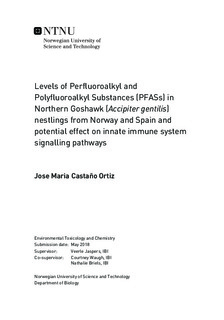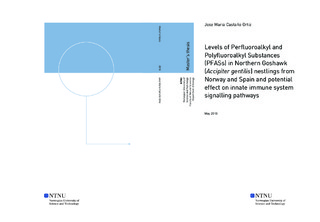| dc.description.abstract | Per- and polyfluoroalkyl substances (PFASs) are environmentally persistent and bioaccumulative chemicals, which reach high levels in apex predators like birds of prey. Immunomodulation is among the most concerning toxic effects linked with PFAS exposure in traditional animal models, and additional studies are needed to determine if and how these apply to birds. Innate immune system signalling pathways provide crucial responses against infection that initiate the clearance of pathogens, and these could be impaired by pollutant exposure. This study aimed to investigate the levels and sources of variation of PFASs in plasma (n=38) and feathers (n=39) from northern goshawk (Accipiter gentilis) nestlings, and evaluate specific immune effects linked with one of the most prominent PFAS using an in vitro avian model. The in vitro experiment was performed using chicken embryo fibroblasts exposed to perfluorooctane sulfonate (PFOS), and infected with gallid herpesvirus-2 (GaHV-2) or the RNA virus analogue poly(I:C). We investigated the expression of microRNA-155, pro-inflammatory cytokines (IL-8 and TNF-α), the transcription factor NF-κB, and the anti-inflammatory cytokine IL-4 at four consecutive time points following viral stimulation.
Goshawk nestlings were found to be exposed to a wide range of PFASs, although at relatively low levels, and comparable to those found in previous studies on birds of prey. PFAS profiles differed between the studied regions, with perfluoroalkyl sulfonates (PFSAs) dominating plasma profiles in Troms and Trøndelag (Norway), and perfluoroalkyl carboxylates (PFCAs) being the dominant class in Spanish birds: linear PFOS was at highest levels in Norway (mean: 6.37 ≈ 5.96 > 2.13 ng/mL), while perfluononanoic acid (PFNA) was the most abundant in Spanish nestlings (mean: 2.77 > 1.05 ≈ 0.75 ng/mL). In addition to the likely underlying contribution of local PFSA and PFCA contamination sources, the diet contributed to explain PFAS levels across goshawk nestlings, as individual burdens increased with trophic level. Additionally, this study showed that PFOS exposure could mediate a downregulation of constitutive immune gene expression in bird cells from 36h post-exposure. Overall, these findings indicate that PFOS might deregulate innate signalling pathways and cytokine release in birds, but results should be interpreted with care because the experimental dose of PFOS (22 ppm) is generally not relevant for bird exposure, and the effect of PFOS on virus activated pathways could not be demonstrated here. Further research on the impact of pollutants on host-virus interactions is recommended, as they have been overlooked and might contribute to understand disease outcomes and outbreaks in birds of prey, together with other factors like host genetics or the evolving nature of infectious agents. | |

